Nickname(s) Ralph Monclar Name Raoul Magrin-Vernerey | Years of service 1912–1964 Allegiance France | |
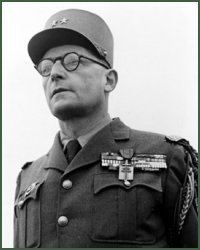 | ||
Born 7 February 1892Budapest, Hungary ( 1892-02-07 ) Rank General de corps d'armee Awards Grand Cross of the Legion d'honneurCompanion of the LiberationMedaille militaireCroix de guerre 1914–1918Croix de guerre 1939–1945Honorary Knight Commander of the Order of the British Empire (UK)Silver Star (US) Died June 3, 1964, Paris, France Similar People Matthew Ridgway, Peng Dehuai, Zygmunt Bohusz‑Szyszko, Carl Gustav Fleischer, Clark L Ruffner | ||
Raoul Charles Magrin-Vernerey, other known as Ralph Monclar born February 7, 1892, was a French officer and 2nd Inspector of the Foreign Legion who fought in World War I, World War II, and particularly within the ranks of the Free French Forces and the French Battalion in the Korean War. He was also one of the first superior officers to respond to the Appeal of 18 June.
Contents
- Early life
- World War I
- Interwar period
- World War II
- Korean War service
- Later life and death
- Hommages
- French Decorations
- Foreign Decorations
- References
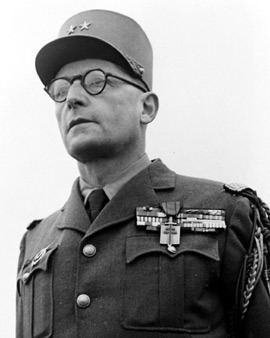
Early life

Following studies at the Victor Hugo school, he was only 15 years old when he first tried to volunteer for the French Foreign Legion. In reason of his young age, he was not admitted and returned to continue his studies.
World War I

Admitted to École spéciale militaire de Saint-Cyr in 1912, he graduated in 1914 part of the de Montmirail promotion with the rank of Sous-Lieutenant. On August 5 of the same year, he joined the 60th Line Infantry Regiment (French: 60e régiment d'infanterie de ligne, 60e R.I.L) and completed the war with rank of captain. He was accordingly titled with knight order of the Légion d'honneur and 11 citations, wounded 7 times and subsequently reformed with a 90% invalidity mainly the effects of bullets, grenade explosion, trepanning wounds and the effects of lethal gas.
Interwar period
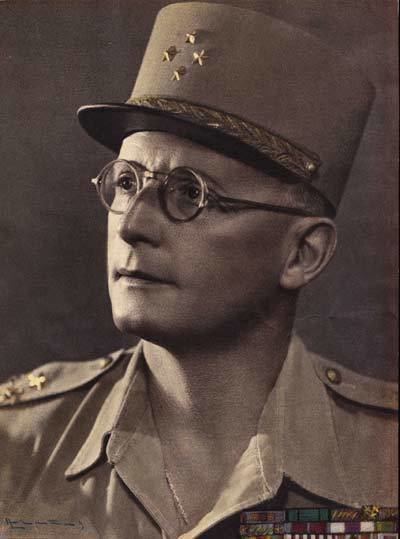
Following the Armistice of 11 November 1918, he was put at the disposition of the allied chief commander of the Orient, he joined then the headquarter staff as chief of the first bureau in the beginning of 1919. Accordingly, he was administered by the 1st Moroccan Tirailleur Regiment (French: 1er Régiment de Tirailleurs Marocains, 1er R.T.M). On September 25, he was designated to conduct a training program at the Center of Aviation of the 415e RI of San Stefano where he was appointed as an aviation instructor. Following this particular formation, he joined the administrative services of the Levant in Beirut, as an adjoint to the administrator. He was accordingly designated as an administrative council on March 1, 1920 then inspector on October 19. In this post, he earned a citation at the order of the armed forces. On May 11, 1921, he was designated in charge of forming Legion units present in the Levant. Accordingly, he was assigned to the 4th combat company of the 1st Squadron, a squadron which he assumed the command of on July 1. Within context, he held that position and function long enough to become the adjoint of the regimental commander.
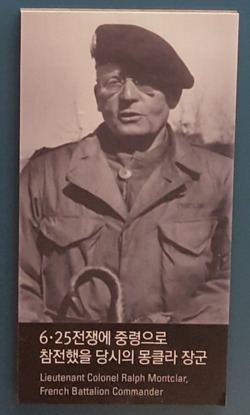
On March 1, 1924, he finally joined the ranks of the French Foreign Legion sought since his minor age. After a brief touring with the 1st Foreign Infantry Regiment, he was assigned to the 3rd Foreign Infantry Regiment, 3e R.E.I (the recently redesignated Marching Regiment of the Foreign Legion) and took part in the Moroccan campaign until 1927. Following, he joined the Middle East (French: Proche Orient) where he was promoted to rank of chef de battaillon (commandant) in 1928.
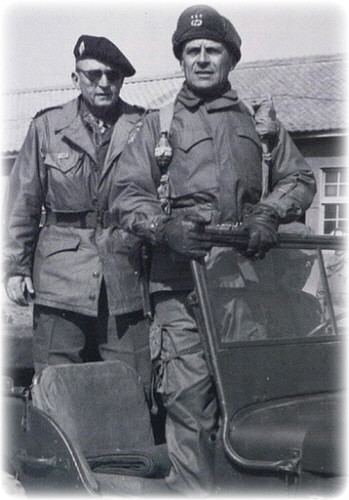
On October 14, 1930, he was designated to take command of the 16th Chasseur Battalion à Pied (French: 16e Bataillon de chasseurs à pied, 16e B.C.P).

Following this command, he was reassigned to the Legion in 1931 and would not leave this function until October 1941. During this 10-year tenure, he was assigned to the 2nd Foreign Infantry Regiment, 2e R.E.I, then stationed in Morocco and joined the 5th Foreign Infantry Regiment, 5e R.E.I in Tonkin.
World War II

Returning from the Far East, he assumed in January 1938 command of the instruction battalion at Saïda, while being promoted to the rank of Lieutenant-colonel on June 25 of the same year, prior to embarking to Morocco with the 4th Foreign Infantry Regiment 4e REI. On February 23, 1940, he rejoined the 3e R.E.I which formed a mountain marching battalion groupment. He was designated as a regimental commander of 2 Legion battalions which formed the 13th Light Mountain Demi-Brigade of the French Foreign Legion (French: 13e Demi-Brigade Légère de montagne de Légion Etrangère, 13e DB.L.MLE). Regrouped first in Larzac then Sathonay, his unit prepared for a campaign with destination unknown. This would the beginning of the 13th Demi-Brigade of the Foreign Legion, 13e DBLE.
On May 13 at Bjervik in Norway, the 13e DBLE delivered the first fire baptization, conquered four objectives and forced opposing forces to retreat while abandoning numerous prisoners, automatic arms, equipment almost impossible to count and 10 bomber aircraft.
From May 28 to June 2, Lieutenant-colonel Magrin-Vernerey and his legionnaires were victorious at Narvik, which was referred to as "the only french victory of 1939-1940" (French: « la seule victoire française de 1939-1940 »). This victory was worth being cited at the orders of the Free French Forces, with attribution of the croix de guerre bearing palme de vermeil, for having liberated 60 allied prisoners, apprehending 400 opposing prisoners, capturing 10 cannons and significant material.
Barely back to France with 500 of his men, he rejoined the Free French Forces in England on June 21, 1940 and adopted the name de Monclar (from the village name of Monclar-de-Quercy, in Tarn-et-Garonne). Following, he was promoted to the rank of Colonel.
Participating to operations against the forces of Axis of Africa and while heading the 1st Free French Division 1e DFL, he took part in the Battle of Keren and the Battle of Massawa.
In June 1941, he refused to take part in combat action against other French Forces in the Levant and particularly refusing to fight against the legionnaires of the 6th Foreign Infantry Regiment. Following, he was replaced at the head of the 13e DBLE by Lieutenant-colonel Prince Amilakvari and led the unit across northern Libya and into Tunisia.
Promoted to the first section of officer generals, he exercised various command in the Levant, participated to numerous campaigns and finished his tour as the superior commander of troops in the Levant.
Becoming adjoint to the superior commander of troops in Algeria since 1946, he was in 1948 designated as 2nd Inspector of the Foreign Legion charged with the permanent mission of inspecting Legion units until 1950. During almost these two years, he would permanently set on voyages to the various continents where the Legion would station and engage in combats, including Algeria, Morocco, Madagascar and Indochina.
In 1950, général de corps d'armée, at the eve of his retirement from active duty service, he volunteered to command the United Nation French battalion in course of formation and exchanged his stars against galons (ranks) of a Lieutenant-colonel.
Korean War service
Rather than retire, at age 60, Monclar volunteered to join the French forces fighting in Korea. That force was known as the bataillon de Corée, and was attached to the 23rd United States Infantry Regiment as part of the 2nd Infantry Division. Monclar took a temporary demotion from lieutenant general to lieutenant colonel in order to command that formation. According to U.S. Army General Matthew Ridgeway:
I shall speak briefly of the 23rd US Infantry Regiment, Colonel Paul L. Freeman commanding, [and] with the French Battalion. Isolated far in advance of the general battle line, completely surrounded in near-zero weather, they repelled repeated assaults by day and night by vastly superior numbers of Chinese. They were finally relieved. I want to say that these American fighting men, with their French comrades-in-arms, measured up in every way to the battle conduct of the finest troops America and France have produced throughout their national existence.
Later life and death
Attaining the limit of service age, he returned to France in 1951. In 1962 and while succeeding général Kientz, he became governor of the Les Invalides
It is in this honorary post that he died on June 3, 1964 at Val-de-Grâce in Paris.
He was also the founding president of the national association of United Nations French Forces of the Korean Regiment.
